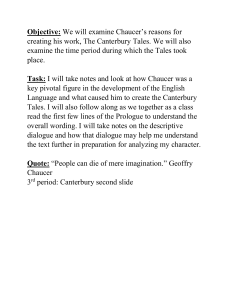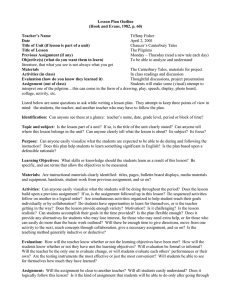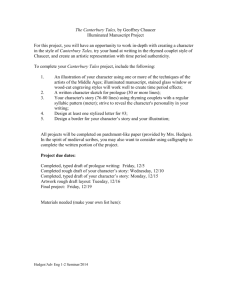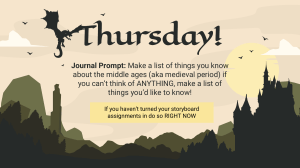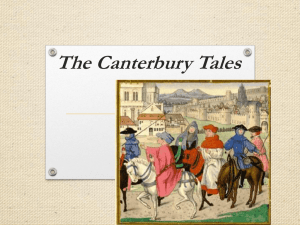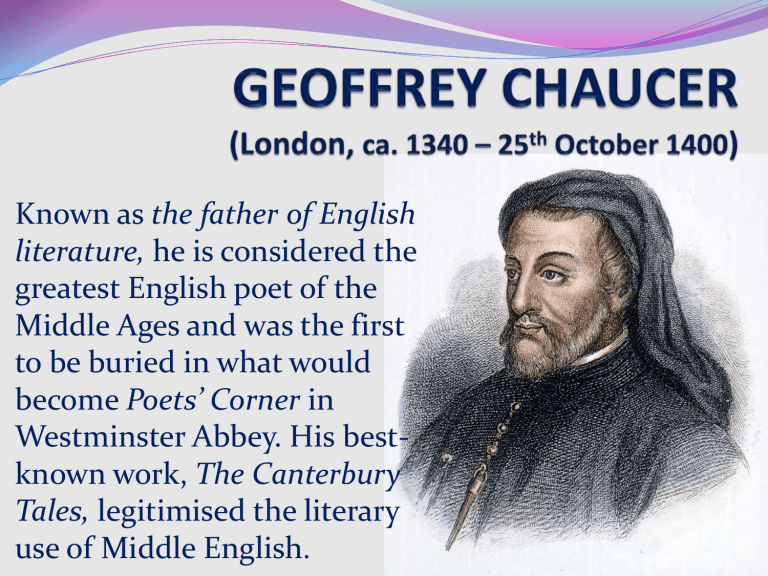
Known as the father of English literature, he is considered the greatest English poet of the Middle Ages and was the first to be buried in what would become Poets’ Corner in Westminster Abbey. His bestknown work, The Canterbury Tales, legitimised the literary use of Middle English. SECTION SUMMARY 2 GEOFFREY CHAUCER ca. 1340: he was born most likely at his parents’ house in London. His was an affluent, middle-class family who made their money in the London wine trade. He received an excellent education, became competent in French and Middle English as well as Latin, and found employment in the house of John of Gaunt, son of King Edward III of England. 1360s: he joined the Royal Service, travelling throughout France, Spain and Italy on diplomatic missions. 1366: he married Philippa de Roet, a lady-inwaiting of the Queen. The marriage helped further his career in the English court. 4 GEOFFREY CHAUCER • ca. 1368-9: he published his first important poem, The Book of the Duchess, an elegy for the death of John of Gaunt’s first wife, in which he used the dream-vision form. • the 1370s: he was at various times on diplomatic missions in Flanders, France, and Italy. Along the way he also spent time familiarizing himself with the work of Italian poets Dante, Petrarch, and Boccaccio, and this would have profound influence upon his own writing. ca. 1378-81: his second work was The House of Fame, a poem of more than 2,000 lines, also in dream-vision form. 5 GEOFFREY CHAUCER In the same years he published The Parliament of Fowls (or Birds), an indictment of courtly love staged as an allegory with birds corresponding to social classes and marriage of convenience as its theme. ca. 1382-1386: in his poem Troilus and Criseyde Chaucer retold the medieval romance of doomed lovers, setting his epic poem against the backdrop of the siege of Troy. The poem takes its story line from Giovanni Boccaccio’s Il Filostrato (1335-1340), but its inspiration from Dante’s love for Beatrice and Petrarch’s love for Laura. 1387: his wife died and the period which followed was an unfavourable one for him, both politically and financially. 6 GEOFFREY CHAUCER In the same year he began working on The Canterbury Tales. 1389-1391: appointed Clerk of the King’s Works he was robbed several times and once beaten. 1399: after a long period of hardship, the pension he had been living on was reinstated and he took a lease on a house in the garden of Westminster Abbey. 1400: he died of unknown causes on 25th October in London. He was buried in Westminster Abbey and his gravestone became the center of what would later be known as Poets’ Corner. 7 THE CANTERBURY TALES The Canterbury Tales is a long narrative poem, told in verse, written in Middle English, and structured in three parts: ❑ a General Prologue which introduces the characters and the setting of the work; ❑ the Prologues to the single tales (as well as the Epilogues, in some cases); ❑ the twenty-four Tales themselves. It gives insight into individual characters as regards their lifestyles, their psychology and experiences, questioning the complexity of the human condition and always seeing both the humour and the tragedy in it. 9 CONTENT In the poem a group of 30 pilgrims (which includes the poet himself) gather at the Tabard Inn in Southwark, across the Thames from London, and agree to engage in a storytelling contest as they travel on horseback to the shrine of Thomas Becket in Canterbury, and back. Harry Bailly, host of the Tabard, serves as master of ceremonies for the contest: whomever he judges to be the best storyteller will receive a meal at his tavern, courtesy of the other pilgrims. The characters are described both as individuals and as stock characters, representative of a social class. 10 MEDIEVAL SOCIETY Medieval social theory divided society into three broad classes, called “estates”: 1. the military, which included the nobility since it traditionally derived its title and privileges from military service and duties; 2. the clergy, which again, at times, overlapped with the noble class since the system of primogeniture favoured the eldest male heir; 3. the laity, i.e. 90-95% of the population, which ranged from landowners and professionals to labourers and peasants. 11 WHY A PILGRIMAGE? The use of a pilgrimage as a framing device for the collection of stories enabled Chaucer ❑ to bring together people from many walks of life; ❑ to present a highly varied collection of literary genres: courtly romance, saint’s life, allegorical tale, beast fable, medieval sermon, alchemical account…; ❑ to make extended consideration of the relationship between the pleasures and vices of this world and the spiritual aspirations for the next. Moreover a pilgrimage to Canterbury made the work very “English”! 13 From TRADITION … The Canterbury Tales presents similarities with Italian literature: it draws on the technique of the frame tale as practised by G. Boccaccio in The Decameron (1349-1351), though we are not sure if Chaucer knew this work in its entirety. The pretext for storytelling in Boccaccio is a plague in Florence which sends a group of ten nobles to the country to escape the Black Death. During the following ten days each of them tells a tale around a topic chosen by the “King” or “Queen” of the day. At the end of the book the hundred tales are completed, the plague ends and the nobles return to Florence. 14 … to INNOVATION. The Canterbury Tales innovates on this model in significant ways: ❑ far from being noble, Chaucer’s tale-tellers run the spectrum of the middle class; ❑ the tales are not told in the order that might be expected, i.e. from highest-ranking pilgrim to lowest; ❑ each character uses his tale as a weapon or tool to get back at or to get even with the previous tale-teller. Moreover Chaucer presides over the whole expanse of his narrative as the poet but also as the pilgrim! 15 THEMES, LANGUAGE & STYLE Intrigued by human nature and its frailty, Chaucer was an acute observer of daily life at many levels; therefore his themes vary from religion to magic, from love to marriage, through stories about people as well as stories about animals, many of which carry a moral message. He was the first writer to promote (Middle) English as a literary language, in place of French or Latin, and he used an innovative verse form, the heroic couplet. His style is lively and witty, humorous and vibrant as well as highly poetic and delightfully entertaining. 16 GENERAL PROLOGUE (ll. 1-11) When in April the sweet showers fall And pierce the drought of March to the root, and all The veins are bathed in liquor of such power As brings about the engendering of the flower, 5 When also Zephyrus with his sweet breath Exhales an air in every grove and heath Upon the tender shoots, and the young sun His half-course in the sign of the Ram has run, And the small fowl are making melody 10 That sleep away the night with open eye (So nature pricks them and their heart engages) 18 GENERAL PROLOGUE (ll. 12-18) Then people long to go on pilgrimages And palmers long to seek the stranger strands Of far-off saints, hallowed in sundry lands, 15 And specially, from every shire’s end Of England, down to Canterbury they wend To seek the holy blissful martyr, quick To give his help to them when they were sick. 19 SUMMARY The General Prologue opens with a description of the return of spring hailed by the April rains, the blossoming flowers and leaves, and the chirping birds (ll. 1-11). Around this time of year people begin to feel the desire to go on a pilgrimage: many devout English pilgrims set off to visit shrines in distant holy lands, but even more choose to travel to Canterbury to visit the relics of Saint Thomas Becket inside the Cathedral, where they thank the martyr for having helped them when they were in need (ll. 12-18). 20 GENERAL PROLOGUE (ll. 19-29) It happened in that season that one day 20 In Southwark, at The Tabard, as I lay Ready to go on pilgrimage and start For Canterbury, most devout at heart, At night there came into the hostelry Some nine and twenty in a company 25 Of sundry folk happening then to fall In fellowship, and they were pilgrims all That towards Canterbury meant to ride. The rooms and stables of the inn were wide; They made us easy, all was of the best. 21 GENERAL PROLOGUE (ll. 30-42) And, briefly, when the sun had gone to rest, I’d spoken to them all upon the trip And was soon one with them in fellowship, Pledged to rise early and to take the way To Canterbury, as you heard me say. 35 But none the less, while I have time and space, Before my story takes a further pace, It seems a reasonable thing to say What their condition was, the full array Of each of them, as it appeared to me, 40 According to profession and degree, And what apparel they were riding in; And at a Knight I therefore will begin. 22 SUMMARY The narrator tells us that as he prepared to go on such a pilgrimage, staying at a tavern in Southwark, the Tabard Inn, a company of twenty-nine travellers entered (ll. 19-24). The travellers were a diverse group who, like the narrator, were on their way to Canterbury. They happily agreed to let him join them. That night, the group slept at the Tabard, and woke up early the next morning to set off on their journey (ll. 25-34). Before continuing the tale, the narrator declares his intent to list and describe each of the members of the group, and states that he will start from a Knight (ll. 35-42). 23 ANALYSIS (1) The opening invocation of spring is lengthy and formal compared to the language of the rest of the Prologue. The first lines situate the story in a particular time and place but it does so in cosmic and cyclical terms, giving the lines a dreamy, timeless, unfocused quality. In line 20, the narrator abandons his all-knowing point of view, identifying himself as an actual person, “I”, and then shifting into the first-person plural, referring to the pilgrims as “we”, thus asserting his status as a member of the group. 24 ANALYSIS (2) His comments in l. 35 (“while I have time and space”) underscore the fact that he is writing some time after the events of his story, and that he is describing the characters from memory. As a result the descriptions will be ❑ subject to his memory; ❑ shaped by his personal perceptions and opinions. Nevertheless his declaration that he will tell us about “their condition,” “array,” (dress) and “degree” suggests that his portraits will be based on objective facts, as we can see in the description of the Wife of Bath. 25 THE WIFE OF BATH (ll. 445-456) There was a housewife come from Bath, or near, Who- sad to say- was deaf in either ear. At making cloth she had so great a bent She bettered those of Ypres and even of Ghent. In all the parish there was no goodwife Should offering make before her, on my life; And if one did, indeed, so wroth was she It put her out of all her charity. Her kerchiefs were of finest weave and ground; I dare swear that they weighed a full ten pound Which, of a Sunday, she wore on her head. 27 THE WIFE OF BATH (ll. 457-468) Her hose were of the choicest scarlet red, Close gartered, and her shoes were soft and new. Bold was her face, and fair, and red of hue. She’d been respectable throughout her life, With five churched husbands bringing joy and strife, Not counting other company in youth; But thereof there’s no need to speak, in truth. Three times she’d journeyed to Jerusalem; And many a foreign stream she’d had to stem; At Rome she’d been, and she’d been in Boulogne, In Spain at Santiago, and at Cologne. 28 THE WIFE OF BATH (ll. 469-478) She could tell much of wandering by the way: Gap-toothed was she, it is no lie to say. Upon an ambler easily she sat, Well wimpled, aye, and over all a hat As broad as is a buckler or a targe; A rug was tucked around her buttocks large, And on her feet a pair of sharpened spurs. In company well could she laugh her slurs. The remedies of love she knew, perchance, For of that art she’d learned the old, old dance. 29 SUMMARY The woman from Bath is an impressive female character: an expert weaver headstrong and bold, deaf in one ear, she shows off her rich Sunday kerchiefs with evident pride (ll. 445-456). Elegantly dressed and extremely self-confident, she is very wealthy and has been married five times. She goes on pilgrimages rather often because she loves travelling and meeting people (ll. 457-468). Sensual and lustful as indicated by her gap-tooth, she is sociable and amusing as well as a good love-counselor thanks to her experience in matters of love (ll. 469-478). 30 ANALYSIS The Wife of Bath is a force of nature, a larger -than-life character who is not afraid to push her way to the front and state her opinions. She represents the woman of the 14th century, who had started crossing the boundary of restrictions imposed upon women by society. Her creation was influenced by Chaucer’s idea of female stereotype, i.e. domineering, lustful, short-tempered and deceitful: he exploited it to create a complex character, new and original, surprisingly emancipated and quite 31 unforgettable! LEGACY The high literary standard of The Canterbury Tales led Chaucer’s contemporaries to praise his artistry, and a “school” of 15th -century Chaucerians imitated his poetry. Aside from this, the work stands as a historical and sociological introduction to the life and times of the late Middle Ages: Chaucer presented the world as he saw it showing a deep understanding of human nature. Over the succeeding centuries, his poems have been widely read, translated into modern English, studied and taught by an increasing number of scholars and critics especially since about the middle of the 19th century. 33


